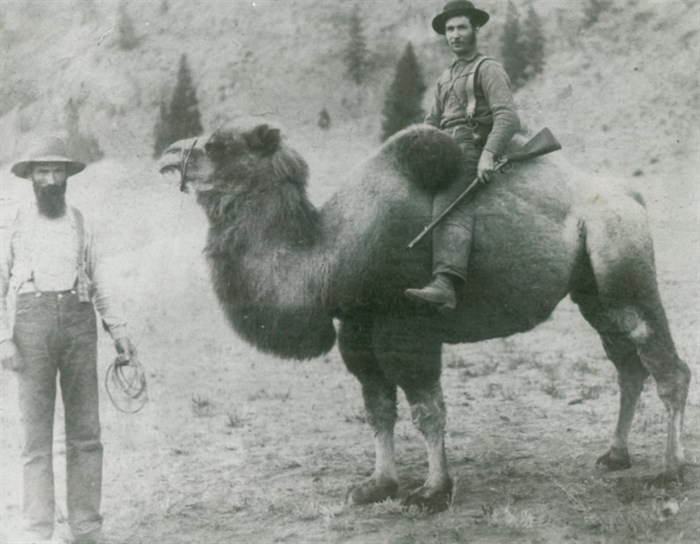
This is the only known photo of the Cariboo Camels. The camel pictured was the last remaining, which died in 1905. Archie MacPhail is riding the animal, and a man referred to as G. Smith is holding the lead.
Image Credit: TWITTER- Kamloops Museum and Archives
August 29, 2019 - 6:00 AM
KAMLOOPS - Camels were once an unusual part of B.C.'s gold rush.
Their involvement started when an agent from San Francisco was advertising the sale of Bactrian camels as pack animals. An editor of the Victoria Colonist heard about the sale and published an ad for the animals in a March 1862 printing.
A rancher and packer from Seton Portage near the area of Lillooet, John C. Calbraith, saw the ad and was intrigued. The camels could carry 200 pounds more than a donkey while going longer distances without water. Calbraith purchased 23 of the animals at $300 each, according to the spring 1975 Wildlife Review, volume VII.
The animals arrived in Victoria on April 15, 1862. When they arrived in the capital, they were displayed to a community comprised mostly of people who had never seen such creatures, according to the 1975 Wildlife Review. The animals, as well as Calbraith, were ridiculed.
While on display in Victoria, a newly born calf was being pestered by a man. The mother camel did not pay much attention to the pest, until he turned his attention to her, according to an article in the Victoria Colonist. The article states the mother grew frustrated and snorted out “two gallons of dirty water”. The article says the mother and calf then simply left the area and were spotted a few times within six months of leaving, and then never again seen.
After spending some time in Victoria, the animals were sent to New Westminster, according to the city’s local ‘British Columbian’ paper. It reported that only 21 arrived, meaning another, in addition to the mother and calf, was gone. That was the start of the mystery around disappearing camels. The calves born were not accounted for in the counts of the animals.
According to records from the 1975 Wildlife Review, the animals were not suited for the conditions of British Columbia. The report states their feet were too soft for the rocky terrain of Cariboo Road, and their scent scared any horses, mules, or dogs on the same trip. The same article states that one camel was spooked while on the Pavillion Trail, and toppled another heavily loaded camel over the cliff’s edge. It was believed their long legs would help them with winter snow, but 12 of the animals died during a cold blizzard, according to an article in the B.C. Digest. During the cold months, the camels took some downtime, although it is not certain where.
On May 12, 1863, the camels were put back to work, according to the Victoria Colonist. A correspondent for the newspaper said the animals were better pack animals than mule, ox, wagons. He also noted that the animals had become more acclimated to their environment, and would eat anything from a pair of pants to a bar of soap.
Although there wasn’t much documentation of their endeavours, an article from the Victoria Colonist from Oct. 15 1863 of the same year says that approximately 12 of the camels remained.
Although there has been a longstanding controversy about if the animals were used for meat, little information is available. Mrs. C. H. Dunsmore, was the great-granddaughter of one of the camel handlers, Frank Laumeister. She uncovered notes from the Hudson’s Bay Company in Kamloops showing the company purchased 404 pounds of camel meat for $60.60 from a Grande Praire man.
The scent and behaviour of the camels sometimes resulted in the loss of other pack animals, supplies, and goods. The animals were deemed unfit for the job after their second season. According to Lillooet Museum's ‘Museum Roundup’ in 1975, many of the camels had already perished, and the man who was watching over them, Laumiester, let the camels loose. Some were never seen again, some were used for their meat. The Museum Roundup states that the last known camel lived into the early 1900s, and was kept as an attraction offering rides for children.
As for the fate of the last-known Cariboo Camel? One day in 1905, the animal walked to the nearest tree, leaned against it, and died.
To contact a reporter for this story, email Jenna Wheeler or call (250) 819-6089 or email the editor. You can also submit photos, videos or news tips to the newsroom and be entered to win a monthly prize draw.
We welcome your comments and opinions on our stories but play nice. We won't censor or delete comments unless they contain off-topic statements or links, unnecessary vulgarity, false facts, spam or obviously fake profiles. If you have any concerns about what you see in comments, email the editor in the link above.
News from © iNFOnews, 2019